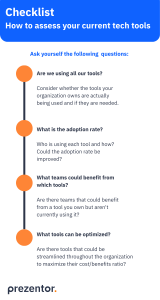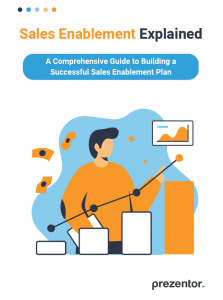How to build a sales enablement tech stack that increases efficiency
Sales enablement’s popularity has skyrocketed over the past few years, and so has the number of related tools and software products. It can therefore be challenging to navigate among this sea of new – and constantly evolving – technology and build a sales enablement tech stack that is right for your business and increases the efficiency of your revenue teams. But fear not: we are here to help. In this article we will guide you through the must-haves of sales enablement and we will highlight some important considerations to make before starting to build your own sales enablement tech stack.
The advantages of having a sales enablement tech stack
It is not enough to have the perfect sales enablement strategy in place, if you do not have the tools that allow you to implement it.
The right sales enablement technology allows you to reach all the advantages of sales enablement, such as:
Alignment: a well-integrated tech stack helps you create a streamlined process across departments, giving you increased alignment among your business functions, which also means increased brand consistency.
Time saving: thanks to automation of manual processes and efficient sales content management, your teams can save a lot of time and focus on revenue-generating activities.
Engagement: the right sales enablement tools make it easier for sellers to engage buyers with fun and interactive content.
Intelligence: adding sales intelligence tools to your sales enablement tech stack gives you useful insights that can make your teams more effective and efficient.
4 Considerations before building a sales enablement tech stack
1. Talk to your revenue teams
Just like planning a sales enablement strategy, building your sales enablement tech stack is a task that should involve several functions in your organization, from Sales to Marketing, to Sales Operations, Customer Success, and so on. Make sure you listen to your teams and take note of any challenges they are facing and any processes they might be struggling with. Chances are there are some tools out there that can help them solve these issues. Also take the time to analyze your organization’s entire sales process and identify any areas that could be improved.
2. Assess your current tools
Before even starting to research new technology, assess the tools you already own. Ask yourself the following questions:
- Are we using all our current tools, and do we actually need them?
- What is the adoption rate of each tool within the company? Who is using it and how?
- Are there teams that aren’t currently using a piece of software and could actually benefit from it?
- Are there any tools that could be streamlined throughout the entire organization to maximize their benefits vs. cost ratio?
3. Make integration and automation a top priority
Do you have automations in place? Are your different tools (and departments) communicating with each other? The priority should be to ensure that core systems have what they need to receive and store data and that they are integrated with each other and accessible to all teams that need them, so that everyone has access to the same updated information. Bear that in mind when researching new solutions and prioritize tools that integrate best with your core systems.
4. Do not lose sight of your goals
It can be easy to get lost in a jungle of sales enablement tools, so make sure you always keep your compass pointing towards your goals. Especially in a time of economic struggles like today, it is important to distinguish between tools that are critical to achieving business goals (or that can at least speed up or facilitate the process greatly) and tools that might be nice to have, but not strictly necessary at this point in time.
Bearing these four considerations in mind, we can now dive deeper into the ocean of sales enablement technology.
The tools your sales enablement tech stack must have
1. CRM software
A good Customer Relationship Management tool should be the heart around which the rest of the tech stack is built. Ideally, this software integrates with most of your tools to collect customer records automatically with every interaction and keep them up to date. This data should then be easily accessible to all the teams that need it, whenever they need it.
2. Sales content management solution
If you invest in nothing else in 2023, make sure you invest in a good solution to manage your sales content, if you don’t already have one. Sales content is critical to capture buyers’ attention, keep them engaged, overcome objections, prove your points, and ultimately close deals. But even the best sales collaterals are useless if they are poorly managed and sellers don’t know where to find them and/or how to use them. Which is why a sales content management solution can greatly improve the efficiency and effectiveness of your sales and marketing teams. Look for a solution that allows you to easily store and distribute the content in one place, and that lets you organize the content by categories, so that it can be found quickly and easily by applying filters. Other important features a sales content management solution should have are the possibility of tracking content performance and usage, and the possibility for sellers to give feedback on content, so that content creation can be constantly improved.
3. Sales communication and engagement tools
It goes without saying that in order to sell you need to reach and engage your buyers. So, of course, communication tools are high in the priority list when building a sales enablement tech stack. With the rise of digitalization and virtual selling, you should focus on tools like email and messaging platforms, videoconference software, virtual presentations, scheduling software, etc. Tools that allow automated follow-up can also be a great way to save time.
4. Analytics and reporting tools
Tracking the performance of your teams and assets is a necessary task to measure the effectiveness of your sales enablement strategy and make data-driven decisions. Sales enablement tools can help you monitor and evaluate key metrics such as lead generation, conversion rates, pipeline velocity, and sales rep productivity. By leveraging the analytics and reporting capabilities of sales enablement technology, you can get an overview of your business’ performance and identify areas of improvement.
5. Training and learning software
Training and continuous learning are critical to the main purpose of sales enablement, which is to equip sellers with the knowledge and tools needed to succeed. Investing in coaching and training is a must to keep sellers updated and allow them to meet rising consumers’ expectations.
6. Proposal and contract management software
Software for proposal and contract management might not be an absolute priority, but it is definitely worth considering. As it provides templates and pre-filled content, it enables sellers to draft proposals and contracts much more quickly, thus saving them a lot of time, and it helps them maintain consistency. These types of tools also improve visibility and tracking of the proposal and contract lifecycle, giving useful insights into the sales pipeline.
7. Customer Success Management tools
Ideally, all the customers’ data acquired through interactions with buyers throughout the sales process, from lead generation to conversion, have been recorded, safely stored, and synced across your various platforms, ready to be handed over to your Customer Success team. For a smooth hand-over, it is a good idea to ensure that the Customer Success team uses a tool that integrates well within your sales enablement tech stack.
8. Sales intelligence tools
Sales intelligence tools offer valuable insights that help with lead generation and scoring. By tracking buyers’ engagement and intent, these tools let sellers know which leads to prioritize because they are more likely to close the deal, thus increasing sellers’ efficiency. They can also track sales activities and measure performance, so sellers and/or sales managers can identify areas of improvement and optimize their sales process by taking data-driven action.
9. Sales enablement platform
Last but not least, let’s talk about those tools that are marketed as “sales enablement platforms”. There are many available on the market and their number keeps increasing, but the features they offer can vary greatly. Most of them include a few (if not all) of the aspects mentioned in this list, from sales content management, to analytics, sales training, etc. Bear in mind what your goals and top priorities are when researching sales enablement software. Chances are that there is one out there that offers the perfect mix of features to suit your needs.
Does it make sense to invest in sales enablement software in 2023?
In times of tight budgets, it is natural to question every investment and wonder if purchasing sales enablement software might be the right move.
There isn’t of course one answer that fits everyone. The keyword in 2023 should be prioritization. Businesses must carefully assess sales enablement software against their goals and budget. It is very likely that financial stakeholders, such as CFOs, will be more and more involved in purchase decisions this year, so you can expect every business case for new software to be evaluated in depth.
It is also true that sales enablement tools can offer great advantages, especially in tough times. With the current rise of inflation and continued increase of digitalization, selling can be more challenging than ever. Add the fact that consumers are more and more demanding and expect excellent buying experiences, and you’ll see why sellers will need all the help and tools they can get to keep updated and informed and achieve their quotas in 2023.
Would you like to learn more about sales enablement? Download “Sales Enablement Explained” and discover:
- What sales enablement is and why it is important
- The main sales enablement activities
- Types of sales enablement content
- Sales enablement KPIs to monitor
- Types of sales enablement tools



